Are Trampolines Without Nets Safe? (The Truth)
Are trampolines without nets safe? They are commonly seen in backyards, but are they worth the risk? Get the truth from the trampoline safety experts.
min read

Many wonder, “Are trampolines without nets safe?”
It’s common to see trampolines without an enclosure net in backyards across the world.
But many people don’t know about the risks of trampolines without nets. And there are SERIOUS risks.
As the leaders in trampoline safety, we’re here to answer this crucial question – truthfully.
Is It Safe to Use a Trampoline Without a Net?
Trampolines without nets are very dangerous. There’s no way around it.
Take a look at the picture below, courtesy of Vuly:

There are a few HUGE red flags here, including:
1. There is no padding over the springs or the metal frame. Springs can trap toes and feet.
2. The open area between the springs presents another falling area.
3. *The lack of an enclosure net significantly increases the chance of falling off the trampoline.
That last point is the main reason why trampolines without nets are dangerous.
According to our internal data, the most serious trampoline injuries occur from children falling off trampolines to the ground.
In total, 27%-39% of injuries on trampolines are caused by falling off.
Do All Trampolines Have Nets Now?
Due to the risks of trampolines without nets, manufacturers started routinely including enclosure nets around the early 2000s.
ASTM Standards – which are the leading principles for selling trampolines in the marketplace – state that all trampolines should have a net.
Now, does this mean that it’s illegal to have a trampoline without a net? No. You can still have a trampoline without a net if you prefer.
But you won’t find many, if any, reputable backyard trampoline brands selling a trampoline without an enclosure net nowadays.
The only trampolines that typically don’t have nets are rebounders (mini trampolines for exercise) or inground trampolines.
We would argue that even inground trampolines should have an enclosure net.

An inground trampoline, courtesy of Capital Play.
Are All Trampoline Nets Created Equal?
Just because a trampoline has a net, doesn’t mean it’s completely safe.
A trampoline that becomes ASTM-certified (a must if you want to be sold by retailers) must meet the following standards:
- The net material and its connection strapping must be shown to last well in outdoor conditions.
- The net material and the net door must be able to survive impact tests without breaking.
- Nets must be a certain minimum height.
- The net needs to be connected well at the bottom so jumpers cannot slide out under the net.
- Support poles must not provide additional impact hazards.
Even with these standards in place, trampoline nets are not standardized in the trampoline industry.
Scroll to the next section to see an example.
A Trampoline Net Comparison
To demonstrate the differences between trampoline nets, look at these nets from Skywalker and Springfree.
Skywalker Trampoline:

Photo courtesy of eBay.
Springfree Trampoline:

Take a look at both trampolines and analyze the nets.
Just by the eye test, you can tell the Skywalker net is quite flimsy. If you were to lean into the net with all your weight, it may not hold up well.
The Springfree net is fabricated using a high-strength Raschel knit, similar to deep-sea fishing nets.
As you can see above, it flexes when you jump into it. You could put all your weight on the net with full force, and the net will still catch you.

**(This picture might look like he’s falling dangerously, but he could actually go all the way to the ground and the net would still cushion his fall – preventing serious injury.)
You can always judge a net’s quality by the length of the trampoline warranty.
The Skywalker net warranty on the trampoline above is one year. The Springfree warranty is 10 years. There’s a major difference in net quality here.
It makes sense since the Springfree Trampoline costs over $1,000 while the Vuly Flare Trampoline is $399.
The point of this comparison is to show that not all trampoline nets are created equal.
If you’re worried about your child’s safety, pay close attention to the net quality. It is one of the most important safety components of a trampoline.
What to Look For In a High-Quality Trampoline Net
The comparison above will give you some context on what to look for in a good net.
For a comprehensive look, here is what makes a quality net:
- Material – High-strength polyethylene or polyester.
- Mesh Density – Look for a tight mesh structure to prevent fingers from getting caught. This is a good example:

- UV Resistance – Always make sure the net has UV resistance – sun exposure can harm the net’s quality.
- Attachment System – Quality nets often have a secure and reinforced attachment system, such as straps and clips, to keep the net in place.
- Zipper Quality – Heavy-duty zippers that won’t jam or break are sneaky important for safety.
- Brand Reputation – High-quality backyard trampoline brands will have safer nets. Plain and simple.
Again -- look toward the trampoline net’s warranty! The length of the warranty gives you a timeframe for how long it will last before needing to be replaced.
Is It Better to Have the Net Inside or Outside on a Trampoline?
What this question is asking is, should the trampoline net be inside or outside of the springs?
The net should always be inside the trampoline, with the springs on the outside, like so:

Photo courtesy of Walmart.
Why?
Having the springs inside the net presents opportunities for the springs to become exposed if the padding wears down.
This can cause painful pinching injuries for children. See below for an example.
If the blue padding around the springs starts to wear down, the springs will become exposed:

Photo courtesy of Wayfair.
Trampoline danger statistics show that contact with the metal springs/frame accounts for around 20% of injuries.
Springless trampolines don’t have this issue. Since they use alternatives to metal springs, there’s no chance of a spring-related injury.
Because they don’t include springs, springless trampolines maximize your jumping room too.
See the Springfree Large Square Trampoline below for an example:

Spring trampolines almost always take off 2 ft of jumping space from their listed size. It might say “14 ft trampoline” but it’s really a 12 ft trampoline mat because the springs take off around 2 ft of room.
Do You Need to Have the Net on a Trampoline?
If you’ve read this far, you know how important an enclosure net is for a trampoline’s safety.
Just in case you need a final answer on whether trampolines without nets are safe, here it is:
You should never jump on a backyard trampoline without a net. EVER.
It’s one of the main and most significant reasons why children get hurt on trampolines.
A net is one of the foundational features of a safe trampoline. Without it, you are setting yourself up for a trip to the ER.
Which High-Quality Trampoline Is Right for You?
Remember, all trampoline nets are not created equal.
If you’re looking for a new trampoline and safety is the priority, you need a trampoline built with quality materials.
We have spent countless hours assessing backyard trampolines. And we’ve expertly chosen the best for this year.
Have a look and take the road to safer jumping: Best Trampolines in Australia

